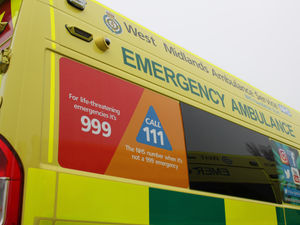Ambulance service to keep buying diesel vehicles with electric conversion 'not commercially viable'
The region's ambulance service will continue to buy diesel replacements after revealing it would cost an extra £70m to replace its fleet with electric vehicles.

West Midlands Ambulance Service's (WMAS) trust board discussed the issue at its latest meeting, where interim director of finance, Paul Jarvis, said that after examining the idea they would continue replacing ambulances with diesel vehicles – as it currently operates.
Mr Jarvis told the board that there were a number of issues preventing the move to using electric ambulances.
He said that cost and range are major factors, and that the car industry does not yet provide the type of vehicles that would be needed for use as ambulances – meaning a costly conversion process is required.
A paper prepared for the board said it would cost £70m over five years to replace all of the service's 480 double-crewed ambulances with electric vehicles.
The report said the change would save £3.7m a year, but that the vehicles would need to run for longer than 15 years to make the saving – something not possible with vehicles requiring replacement after five years.
It stated: "We would need to operate the DCA’s (double-crewed emergency ambulances) for in excess of 15 years to reach a commercially viable position (factoring in eight per cent residual values). The fabric of the vehicle is worn and deprecated at five years, which makes this an impossible position."
Addressing the board Mr Jarvis said: "The capital cost outlay is extensive – two to three times to replace the traditional internal combustion engines.
"There are potential cost savings but the life cycle to recover the costs exceeds the life of the current time frame."
The report outlines how the service has been using a number of electric vehicles albeit ones that are smaller than ambulances, such as rapid response vehicles, IT support vans, and logistics support.
It explains how a trial has been undertaken with an electric ambulance introduced at the Erdington hub in 2020 – which had worked well, but would not be viable in non-urban areas.
The report states: "Range and re-charge time is a significant limiting factor, particularly with the DCA, our vehicle operates out of Erdington, the range of 100 miles is more than sufficient to cover a shift – if we were to move this vehicle to most of our other hubs (outside the conurbation) it would not be, rural areas in particular are covering twice this mileage and more in a shift as an example."
The report outlines how the reduction of costs for moving to an electric fleet is reliant on major manufacturers developing solutions.
It states: "Vehicle manufacturers are focussing their research and development in the sectors of the market where the most volume of sales can be achieved – for light commercials this is the 3.5 ton or less van with limited or no conversion work required, delivery vans being a prime example.
"Companies like Amazon, DHL and DPD are investing heavily in their ‘last mile’ fleet – with current technology that’s eminently feasible, technically, operationally and financially.
"Our experience from the two years operating these vehicles has been invaluable, it has provided us the opportunity to exponentially increase our knowledge of this technology in real world operation.
"With regards to the transition of our heavily converted DCA and PTS (patient transport service) fleet what is clear is it is problematic to deliver – technically, operationally and commercially.
"From the financial comparisons provided in this paper arguably it isn’t commercially viable with the technology available today to introduce on a large scale.
"The solution needs to come from the major manufacturers – we believe it will come but it will be a trickle-down effect as the higher volume sales areas mature."
It added: "WMAS should continue to deliver ambulance vehicles on the diesel platforms based on the five-year replacement cycle. This five-year life supports the value for money operating costs of diesel vehicles (avoiding escalating costs of years six/seven maintenance) and ensures each vehicle has the lowest emissions output possible at this time.
"It is accepted that the vehicle life of an electric ambulance vehicle may need to be longer based on the high capital value and also make sense from an operating costs perspective in the future electric fleet.
"The trust continue to work with national teams, manufacturers and convertors to progress the products and vehicles which will form the future ambulance fleet. WMAS are considered a trailblazer and robust partner in delivering innovative and workable solutions in the electric vehicle space.
"Further planning should be undertaken to understand the full infrastructure capabilities and costs but this will need to dovetail with the arising opportunities – vehicles and funding."





